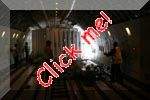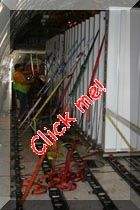
Welcome, from sunny Australia!
My Aviation Page - Some more pictures of the 747

My Aviation Page - Some more pictures of the 747
| From the odd unfortunate
aeroplane accident you have no doubt heard about the famous 'black box'
that always survives the accident. Well, as you can see from the photo
on the right, they're not black, they're orange. The one on the left is
the Cockpit Voice Recorder and it records the last 30
minutes of sound in the cockpit before the power goes off. The reason
for only 30 minutes is the when they were first introduced the US
pilot's union stronlgy objected to anything longer than that because
they were worried that the recordings would be wrongly used to convict
pilots for things they said in general conversation. So a blanket 30
minutes was agreed on. This is generally more than enough but on odd
occasions there have been accidents where the initial stage of the
accident happened more than 30 minutes before and so the cause &
discussion of that is lost. The box on the right is the Flight Data Recorder and it records a lot of things like power settings, control surface positions, altitude, heading, etc. It'll record through a 25 hour window. From the data it provides the flight path of the plane can be accurately determined, and so usually the cause of the accident. If you look at the photo right up the top-right of this page, the rear pressure bulkhead photo, you can see where the two boxes sit in the fuselage. |
| The 747-236 freighters
we use were modified by British Airways a few years before we bought
them, and they were fitted with a Honeywell F light Management System
just like the 737 Classic,
757/767, 777, and 747-400 has. Apparently it turned out to be not that
hard to do, as the systems were easy to integrate. It allowed BA to run
the planes more efficiently and far more accurately than before, thus
saving fuel, etc. There was fifteen converted, Air Atlanta have three
so
the other twelve are still out there somewhere.(I think most are
sitting out in a desert somewhere, in storage) The FMS is pretty
easy to learn how to use, and once you get used to it, it's quite a
handy tool. On the map display in the middle you can see how the
weather
is superimposed over the purple track line and that certainly makes it
very easy to plot a track around bad weather. |

|

|
 |
|
It's not commonly known, but
Saudi Arabia grows quite a lot of wheat. I'm not sure of the
technicalities, but I think they have a lot of ground water that they
pump up to water the wheat fields with. The watering equipment must go
around in a big circle, as all the fields are round - They're also very
large. If you look at the first two photos you can see that there's
thousands of those crop circles around the place (Those photos are of
just one of many areas - Wadi Al Wasir - in the country) but you
don't really get the perspective of how large they are. Look at the
photo on the right and you'll see in between some buildings between
the crops; large buildings, with little dots that're tractors near
them. They're big! The photo on the far right is one I took in mid-June 2007 and it's of yet another area of extensive wheat crop circles, but this one was surrounded by a huge rolling desert. But as you can see, the desert moves around a lot as has partly reclaimed the cleared area. |
|
|
The 747 has pressure relief valves for the pressurisation system to stop the cabin from being over-pressurised. There's a total of four valves, two to a side, and the first ones to open work at 9.25psi, the second set at 9.6psi. You can see them (arrowed) just ahead of the leading edge of the wing root. |
 |
 |
 |
| In mid 2005 we carried two horse hyperbaric chambers out of Melbourne. Each of them weighed sixteeen tonnes and only just fitted through the door. And I mean by maybe a couple of centimetres! In the photo on the right you can see they needed a small forest of straps to hold them in place. The chambers are used to help race horses heal faster and better from injuries, by exposing them to an atmosphere of about two bar (~30psi above ambient) of a high concentration of oxygen. |
More Aviation links can be found on my Links page.